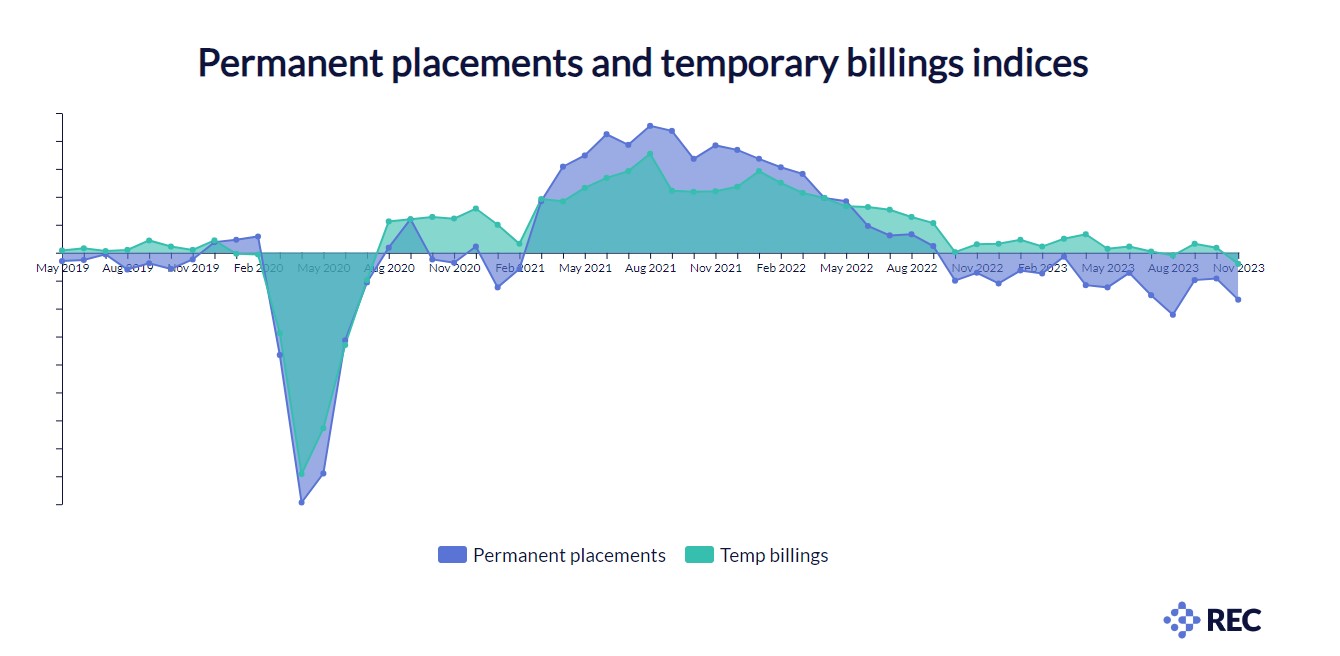
The start of 2024 brings with it a wealth of opportunities and challenges in the recruitment landscape. According to the latest KPMG and REC, UK Report on Jobs survey, the job market continues to show permanent placements and temp billings declined again in December.
According to the report, these are the key findings:
- Sharp Rise in Candidate Supply:
Despite a slight easing from the near three-year record in November, the supply of candidates continued to rise sharply. This increase is attributed to factors such as redundancies and lower levels of hiring activity, contributing to a larger pool of available candidates.
- Impact of Redundancies and Lower Hiring Activity:
Recruiters mentioned that redundancies and reduced hiring activity have played a significant role in expanding the pool of available candidates. Economic conditions, industry-specific challenges, or other factors may be influencing these trends.
- Competition for Skilled Workers:
Despite the increased supply of candidates, there is still competition for suitably-skilled workers. This suggests that while there may be a higher overall number of candidates, there is a demand for individuals with specific skills, leading to competitive hiring situations.
- Rates of Starting Pay on the Rise:
The competition for skilled workers has resulted in an increase in rates of starting pay. Employers, in order to attract and retain top talent, may need to offer higher starting salaries, bonuses, or other incentives. Latest survey data showed the increase was the second-slowest recorded since March 2021 and below the historical trend. Temp pay growth likewise quickened, climbing to a four-month high, but remained below the long-run average.
- Demand for workers remains subdued:
Total vacancies fell for the third time in the past four months during December. That said, the rate of decline was little-changed from November and only marginal.
- Availability of workers continues to rise markedly:
Candidate availability continued to rise at the end of the year, with panel members frequently mentioning that redundancies and a slowdown in hiring had pushed up labour supply. Although easing from the near three-year records seen in November, rates of expansion for both permanent and temporary candidate numbers remained rapid overall.

Neil Carberry, REC Chief Executive, said: “Recruiters went into 2024 with hope that an upturn is coming, based on feedback from clients. Driving this economic growth would be a huge benefit for us all, leading to more successful firms, higher pay, and the ability to cut taxes and fund public services. But the growth must come first. The Chancellor has already set a date for the Budget – he should use it to set out steps that set firms free to grow the economy, from skills reform to regulatory change, including a more balanced debate on immigration for work and its impact on growth.
“Rising demand for healthcare staff emphasises again the importance of supporting NHS performance. Recruiters can see the impact on long NHS waiting lists in the supply of candidates looking for work – addressing this will be a key way to tackle inactivity. But the plan for NHS staffing needs to deal with 21st Century labour market realities. Medical staff have choices in and power over their careers – working with unions, agencies and other stakeholders on a plan will get the NHS farther than diktat from Whitehall.”
Although recruitment consultancies reported a further decline in hiring activity at the end of 2023, both permanent placements and temp billings fell at softer rates than seen in November. Panel members often mentioned that muted demand for staff and recruitment freezes amid the weak economic climate had weighed on hiring decisions. Permanent staff appointments continued to decline at a notably faster pace than that seen for temp billings.
All four monitored English regions noted a decline in permanent staff appointments at the end of the year, with the Midlands recording the sharpest pace of contraction. Trends for temp billings continued to diverge on a regional basis. While the North of England and London recorded higher billings, declines were seen in the South of England and the Midlands.
The fastest falls in permanent vacancies were meanwhile seen in the Construction and IT & Computing sectors.
Justine Andrew, Partner and Head of Education, Skills and Productivity at KPMG UK, said: “It’s a muted end to the year for the labour market, which despite some loosening during 2023, continues to be tight. While the data for December shows hiring activity for both permanent and temporary roles fell at a softer rate than the previous month, businesses are still making redundancies and pausing hiring due to a lacklustre economic outlook. This has driven a further decline in permanent job opportunities, while we continue to see a rising number of people looking for new work.
“For those lucky enough to start a new role there was another sharp increase in starting salaries due to competition for skilled workers. But the rise wasn’t as high as those seen in recent months as businesses face ongoing pressure on their budgets. Recruiters tell us this pressure is now impacting temporary contracts, with fewer people employed on a short-term basis. Businesses which successfully planned and managed their workforce through the intense Christmas period will be breathing a sigh of relief and hoping 2024 brings some much needed certainty to boost the UK economy and overall productivity.”
FULL ARTICLE HERE